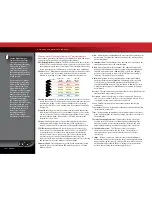
10
•
Slash
The Traxxas TQ Radio System
Use the Right Charger
The most convenient type
of charger is an AC peak-
detecting charger that plugs
directly into an AC wall
outlet. It contains special
peak-detection circuitry
that automatically shuts the
charger off when the battery
is fully charged.
If you’re using a 15-minute
timed charger, always fully
discharge the battery pack
before each charge. Some
high mAh battery packs
(1500 mAh or higher) require
more than the standard 15
minutes of charge time. If
the battery pack is cold after
15 minutes of charging,
add another 5 minutes of
charge time. Closely monitor
the battery pack and stop
charging it when it begins
to feel warm to the touch.
Never leave a battery
charging unattended.
Always follow charger
manufacturer’s instructions.
Radio and Power System Terminology
Please take a moment to familiarize yourself with these radio and power
system terms. They will be used throughout this manual.
BEC (Battery Eliminator Circuit)
- The BEC can either be in the receiver or
in the ESC. This circuit allows the receiver and servos to be powered by
the main battery pack in an electric model. This eliminates the need to
carry a separate pack of 4 AA batteries to power the radio equipment.
Channel
- The 27 MHz frequency band is divided into 6 channels so that
up to six models can be operated simultaneously. Each channel is
referred to by its flag color and channel number, as shown below.
Clearing your frequency
- A routine, verbal check to make sure nobody
else in your area is operating on the same channel. Always clear your
frequency by calling out your channel number before operating
your model. Wait or move to another area if your channel is already
being used.
Crystal (X-tal)
- The plug-in device that determines which channel the
radio system will operate on. For each channel, there are two crystals,
one for the receiver and one for the transmitter. Of those two crystals,
the one marked with the lower number (.455 MHz lower) must be
inserted into the receiver.
Current
- Current is a measure of power flow through the electronics,
usually measured in amps. If you look at wire like a garden hose,
current is a measure of how much water is flowing through the hose.
ESC (Electronic Speed Control)
- An electronic speed control is the
electronic motor control inside the model. The XL-5 uses MOSFET
power transistors to provide precise, digital proportional throttle
control. Electronic speed controls use power more efficiently than
mechanical speed controls so that the batteries run longer. An
electronic speed control also has circuitry that prevents loss of steering
and throttle control as the batteries lose their charge.
Frequency band
- The radio frequency used by the transmitter to send
signals to your model. All Traxxas RTR models operate on a 27 MHz
frequency band.
mAh
– Abbreviation for milliamp hour. A measure of the capacity of the
battery pack. The higher the number, the longer the battery will last
between recharges.
Neutral position
- The standing position that the servos seek when the
transmitter controls are at the neutral setting.
NiCad
- Abbreviation for nickel-cadmium. The original rechargeable
hobby pack, NiCad batteries have very high current handling, high
capacity, and can last up to 1000 charging cycles. Good charging
procedures are required to reduce the possibility of developing a
“memory” effect and shortened run times.
NiMH
- Abbreviation for nickel-metal hydride. Rechargeable NiMH
batteries offer high current handling, and much greater resistance
to the “memory” effect. NiMH batteries generally allow higher
capacity than NiCad batteries. They can last up to 500 charge cycles.
A peak charger designed for NiMH batteries is required for optimal
performance.
Receiver
- The radio unit inside your model that receives signals from the
transmitter and relays them to the servos.
Resistance
- In an electrical sense, resistance is a measure of how an
object resists or obstructs the flow of current through it. When flow is
constricted, energy is converted to heat and is lost.
Servo
- Small motor unit in your model that operates the steering
mechanism.
Transmitter
- The hand-held radio unit that sends throttle and steering
instructions to your model.
Trim
- The fine-tuning adjustment of the neutral position of the servos,
made by adjusting the throttle and steering trim sliders on the face of
the transmitter.
Thermal Shutdown Protection
- Temperature sensing electronics
are used in the ESC to detect overloading and overheating of the
transistor circuitry. If excessive temperature is detected, the unit
automatically shuts down to prevent damage to the electronics.
2-channel radio system
- The TQ radio system, consisting of
the receiver, the transmitter, and the servos. The system uses
two channels: one to operate the throttle and one to operate
the steering.
Voltage
- Voltage is a measure of the electrical potential difference
between two points, such as between the positive battery terminal
and ground. Using the analogy of the garden hose, while current is
the quantity of water flow in the hose, voltage corresponds to the
pressure that is forcing the water through the hose.
Channel
Frequency
Band
Flag
Color
Traxxas
Part No.
1
26.995
Brown
2031
2
27.045
Red
2032
3
27.095
Orange
2033
4
27.145
Yellow
2034
5
27.195
Green
2035
6
27.255
Blue
2036










































